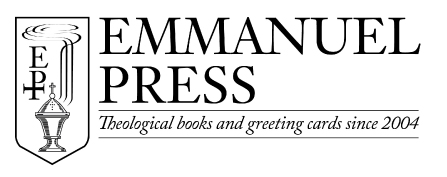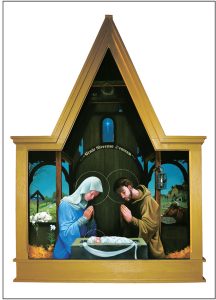THE LATEST NEWS
Thy Kingdom Come: An Excerpt from Thursday of Invocabit (1st Week of Lent)
“He provides for the soul through the body. You can’t wash a soul. So you wash the body with water in the Triune name of God, and the soul is thereby washed. We call that baptism. You can’t touch the soul or feed it apart from the body. So Jesus feeds our bodies with spiritual food, with what the soul needs to be strengthened and cleansed. He does not sit in heaven and think nice things toward us. He actually enters into creation. He speaks through human words, in a human voice. He feeds us when bread and wine become His body and blood, even as He washes us with water.”
-David H. Petersen, author of Thy Kingdom Come
Thy Kingdom Come: An Excerpt from Invocabit (1st Sunday in Lent)
“Eve fell by eating. Jesus resisted taking food from the devil in the desert. And He redeems us by feeding. The same action that plunged the world back to near chaos, that which He denied Himself, now unites and reconciles God’s children to God. His body and His blood are better than manna in the desert. Here is balm for your wounds, courage for your fight, peace for your soul, and the strength you need to face temptation. Here is the Word of God written in stone in the flesh of Mary, hidden in bread, that you would not stand against the accuser but would live as God’s own holy child.”
–David H. Petersen, author of Thy Kingdom Come
Thy Kingdom Come: Lent and Easter Sermons by David H. Petersen
 Thy Kingdom Come
Thy Kingdom Come
by David H. Petersen
This collection of sermons arises from the culture of an active parish life as a part of its usual worship routine. With over sixty sermons spanning Pre-Lent, all forty days of Lent, and the Sundays after Easter, this book now serves as an excellent daily devotion for both pastors and parishioners. Distinctive in his preaching style, Pr. Petersen fluidly interweaves the words of Holy Scripture with his own, immersing us in the text and applying Law and Gospel with sharp insight. As Luther explains in his catechisms, preaching the Word brings the kingdom of heaven from Christ, through the Holy Spirit, to the individual, always pointing us to Christ and Him crucified, died, and risen.
“Every one of Pr. Petersen’s sermons is a bloody mess of Law and Gospel. The mess of your sin and the mess of Jesus’ cross are on display in every sermon. No matter the occasion, no matter the readings, every sermon is about Jesus in His saving work, Jesus crucified for you.” -From the Forward, Rev. Todd Wilken
____________________
Rev. David H. Petersen has been pastor at Redeemer Lutheran Church in Fort Wayne, Indiana, since August of 2000. In addition to his pastoral duties, he is also a prolific writer and magazine editor, serving as editor of the Lutheran journal Gottesdienst, for which he writes on the life and liturgy of the Church. Rev. Petersen has been published in many other journals as well—both scholarly and popular—and is much in demand as a speaker and retreat leader. He graduated from Concordia Theological Seminary with a Master of Divinity in 1996.
Symbolism in the Adoremus Christmas Card
When Ed Riojas created “Adoremus” for ArtPrize 2012 in Grand Rapids, he did more than produce a beautiful work of art. He gave us a masterpiece with incredible theological depth, with subtle, intentional allusions to Messianic symbolism. We asked him to describe the symbolism for us, for it is in the details that we find a greater appreciation for the work as a whole.
Starting with the peak of the frame, then moving to the side windows, and finally to the Holy Family:
- Tripartite construction of the stable and its triangular peak, a subtle nod to the Holy Trinity
- The crown of thorns that literally hangs over Jesus’ head
- A laurel wreath entwined with crown of thorns, to show ultimate victory over death
- Two turtle doves (to the left of the crown of thorns), referring to humility and the 8th-day sacrifice
- The eight-pointed Bethlehem star which announces Christ’s birth but also alludes to His death by its cross shape
- The crucifix in a road-side shrine
- A ram caught in a thicket, just as Abraham’s substitute sacrifice was given to him
- The Rose of Sharon blooming, as the Messiah is now revealed
- The ram and bull are untouched, for now is come down the ultimate sacrifice
- The inn with smoke intentionally excluded from the chimney, showing a lack of hospitality
- The open tomb in front of the inn
- Circular halos, or nimbii, showing figures to be among the saints
- Mary’s blue and white clothing, traditional colors that point to her virginity (purity)
- The lily, which is a symbol of the Virgin Mary
- The draw knife (carpenter’s tool), symbol for Joseph
- The lantern next to the draw knife with a single burning light, representing Christ as the light of the world
- Jesus, the “sign” (Luke 2:12), wrapped in swaddling cloths (in a similar way as a body for burial) and lying in a manger (a typical stone manger of the Middle East, similar to a sarcophagus)
- The Latin included in the piece (Venite Adoremus Dominum) is reflected in the card’s inside text: Word of the Father Now in flesh appearing. O come, let us adore Him.
Find Adoremus and our other Christmas cards here.
Pr. David Petersen, on thanksgiving
“We pray for daily bread not to remind God that we need it, but that He would lead us to realize that He is the giver and that we would receive it with thanksgiving. That word ‘thanksgiving’ happens to be the English translation of the Greek word ‘eucharist.’ Apart from the death and resurrection of Jesus Christ, there would be no mercy and no providence, no bread for hungry people. It is only because the Father has reconciled us to Himself in the Son and declared us righteous that He loves us and that anyone, believer or not, has anything close to what is necessary for this body and life.”
____________
Pr. David H. Petersen — excerpt from his sermon on Laetare (John 6:1-15), included in his upcoming sermon book.

Let’s stay in touch! To receive the most current information on our products and new releases, join our email list today!


